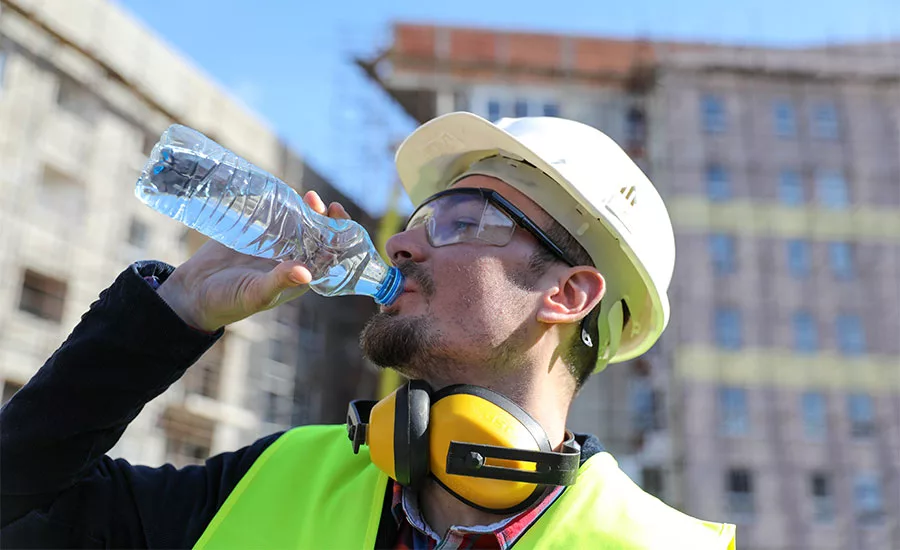Tips to Minimize Summer Heat Risks on Drilling Jobs
Hydration, Rest and Shade Critical to Head Off Heat-Related Illnesses

Regular hydration helps mitigate the potential effects of working for hours in hot temperatures.
Source: Getty Images
Drilling contractors, how often have you found yourself knee-deep in mud on a jobsite working your, um, tail off under the summer sun? My guess is, more than most. When you do, take care of yourself. Don’t fool around and find out what heat stress can do.
Our friends at OSHA say the biggest risks from heat exposure include heat stroke, heat exhaustion, cramps and rashes. They also talk about occupational factors: direct sun exposure, high temperatures and humidity, physical exertion, bulky PPE. Do any of those ring a bell? Maybe all of them, as summer wears on.
We’ve talked a lot, too, about the risks of working in summer weather. Drill trainer Brock Yordy spoke about it in detail in summer 2020 on his Ask Brock show, episode 67.
“It starts by hydration,” Yordy says of safeguarding against the heat, “and making sure we have enough potassium and sodium in our bodies. … When you’re thirsty, you’re already a quart low.”
(He also touched on it in episode 109 and episode 116.)
Of course, folks running crews and managing crews want to minimize risk while maximizing production. That’s the whole point, to get the work done safely and get paid, right? Well, “safely” involves reminders now and again of minimizing those risks. Consider these tactics.
Drink plenty of water: OSHA says about 32 ounces an hour on hot days. You could buy a liter-sized water bottle and commit to refilling it once and hour. That’s easy to remember. In Brock’s video, he reminds drillers to avoid caffeinated drinks and energy drinks, since they don’t hydrate like water will. Your hydration needs may also increase depending on what type of drinks you may have “hydrated” with the night before.
Seek shade: I believe some states mandate shade and water breaks for people who work outside in high temperatures. Take more frequent shade breaks as temperatures climb. You may want to also identify the closest spot with A/C. Maybe it’s the truck cab. Maybe a nearby building. Sometimes, you need to not only seek shade, but also get out of the heat.
Rest often: Yes, it seems to go against productivity, but it’s worth it for you and your crews’ health.
Keep an eye on the heat index: Everyone has a weather app on their phone these days. Watch the heat index, but consider the “index” temperature an app gives you a guide. In full sun, that temperature can be low by as much as 15 degrees Fahrenheit. Consider a heat index threshold for your crews.
Appoint a heat point person: Have someone take charge of making sure everyone else stays safe (and make sure that person has the training needed to recognize heat-related illnesses). Remind folks to drink water. Heck, get bottles of water from the cooler and hand them out. Monitor temperatures. Monitor people in the field for signs of heat stress.
The Driller readers know how to minimize risks and how to assess hazards in different seasons. It can’t hurt to remind folks, though. Crew leaders can discuss all of these tactics during morning toolbox talks. It only takes a minute to raise awareness — or to personally hand out that first water bottle to start the day right.
Before you roll your eyes because you know your limits and would never work yourself into heat stroke, stop for a second and think. How many people set out to get heat stroke? Zero. Thousands of workers become sick from heat exposure in the United States each year. I’d bet none of them intended to. They all weighed safety and production (whatever their industry’s “product” is, from drilled feet to shingled roofs), and made a judgment call. The thing is, hours in the heat with sweat dripping down from a hard hat can make judgment unreliable. Your health and the safety of your crews are at stake. Educate yourself about the risks if you haven’t already. Educate your crews. Hydrate. Rest. Stay cool. Watch the temperatures.
Enjoy the summer and stay safe out there, drillers.
Step Up to the Mic
Working on an interesting project or have industry wisdom to share? Email verduscoj@bnpmedia.com to be considered for a guest spot on Drilling In-Site.
Looking for a reprint of this article?
From high-res PDFs to custom plaques, order your copy today!






